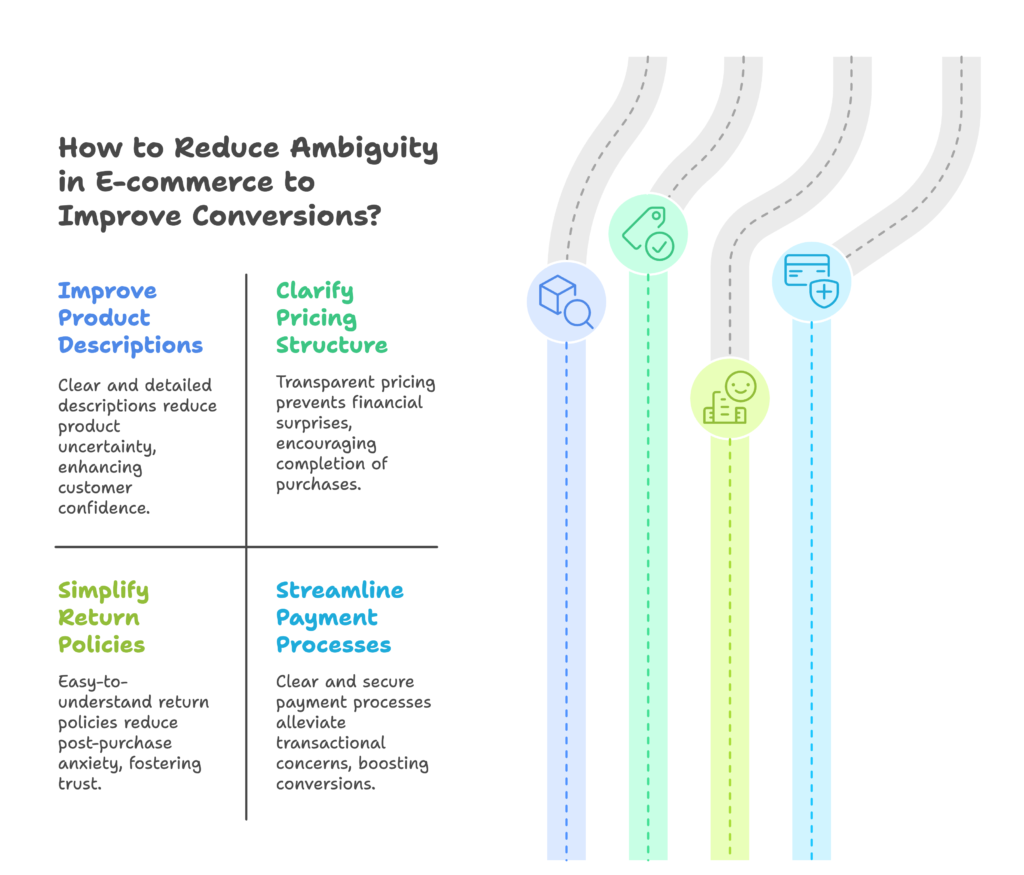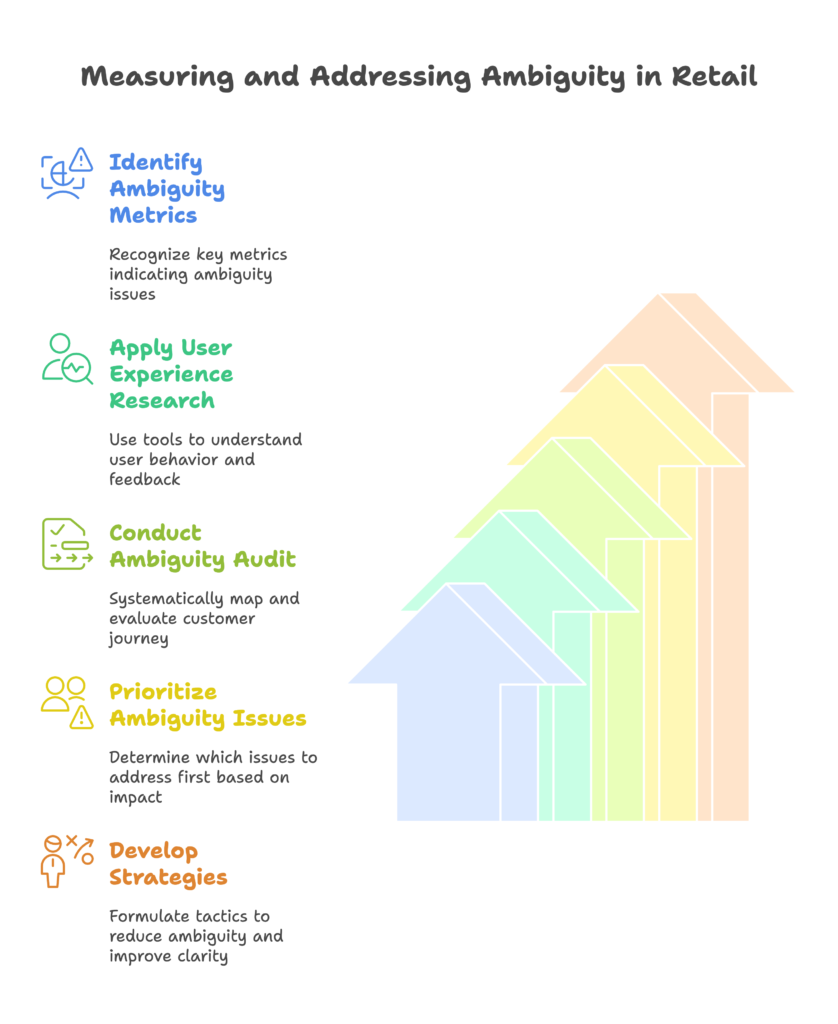Have you ever abandoned an online purchase because you weren’t quite sure about something? Maybe the shipping costs were unclear, or you couldn’t tell if the product would actually solve your problem. If so, you’ve experienced the Ambiguity Effect in action – and you’re definitely not alone.
Uncertainty is the silent conversion killer in e-commerce. When shoppers feel unsure about any aspect of their purchase, they’re much more likely to click away than click “buy now.” The good news? Understanding and addressing ambiguity can dramatically boost your conversion rates.
In this comprehensive guide, we’ll explore how uncertainty affects your Shopify store and provide actionable strategies to create clarity that converts. By the time you finish reading, you’ll know:
- Why our brains are hardwired to avoid ambiguity (and how this impacts your sales)
- How to identify uncertainty points in your customer journey
- Proven tactics to reduce ambiguity and increase conversions
- Step-by-step implementation strategies specifically for Shopify stores
Ready to transform uncertainty into confidence and boost your conversion rates? Let’s dive in!
Introduction to the Ambiguity Effect
Imagine you’re offered two boxes. Box A has 50 red balls and 50 blue balls. Box B has 100 balls, but you don’t know the color distribution. If you need to draw a red ball to win a prize, which box would you choose? Most people select Box A, even though Box B might contain 100 red balls. This preference for known probabilities over unknown ones perfectly illustrates the Ambiguity Effect.
Definition and Core Concepts
The Ambiguity Effect is a cognitive bias where people prefer options with known risks over options with unknown risks – even when the unknown option might actually be better. This bias was first documented in economist Daniel Ellsberg’s famous paradox experiment in 1961, where participants consistently chose options with known probabilities over those with ambiguous ones.
Why does this happen? Our brains are fundamentally uncomfortable with uncertainty. From an evolutionary perspective, ambiguity could signal danger, making uncertainty avoidance a valuable survival mechanism. When we can’t accurately assess risks, our prehistoric brain circuits activate, often triggering an emotional “better safe than sorry” response.
This discomfort isn’t just psychological – neuroscience shows that ambiguity actually activates different brain regions than clear risks do. When faced with ambiguous situations, our brains work harder, consuming more cognitive resources and creating more mental friction.
Relevance to E-commerce and Online Shopping
In the digital world, this effect is amplified. Online shopping is already filled with uncertainty – customers can’t physically examine products, must trust shipping will work as promised, and need to provide personal information. Every additional element of ambiguity increases the cognitive load on your customers.
The numbers tell the story: studies show that up to 68% of cart abandonments happen because of uncertainty factors like unexpected shipping costs, vague return policies, or unclear checkout processes. For Shopify store owners, this represents a massive opportunity – reducing ambiguity is often the lowest-hanging fruit for improving conversion rates.
Now that we understand what the Ambiguity Effect is, let’s explore how it directly impacts your e-commerce conversions. After all, knowing where the leaks in your conversion funnel are happening is the first step to plugging them!
How Ambiguity Effect Impacts E-commerce Conversions
Picture this: A customer is browsing your store, finds a product they like, and adds it to their cart. They proceed to checkout but suddenly pause when they see “shipping costs calculated at next step.” Unsure about the total cost, they decide to “think about it later” – and never return. This is decision paralysis triggered by ambiguity, and it’s costing you sales every day.

Decision Paralysis in Online Shopping
The customer journey is filled with decision points – from product selection to payment method choice. At each touchpoint, ambiguity can create decision paralysis, where customers find it easier to make no decision (abandonment) than to proceed with uncertainty.
Research shows that even small uncertainties compound dramatically. A study by Baymard Institute found that 21% of US online shoppers abandoned orders specifically because they “couldn’t see/calculate total order cost up-front.” Another 11% left because “the return process wasn’t clear enough.” These aren’t customers rejecting your products – they’re rejecting ambiguity.
Common Sources of Ambiguity in Online Stores
Uncertainty lurks throughout the e-commerce experience:
- Product descriptions and specifications: Vague descriptions, missing dimensions, or unclear uses create product uncertainty.
- Pricing structure: Hidden fees, unclear shipping costs, or confusing discount applications create financial uncertainty.
- Return policies: Complicated or hard-to-find return information creates post-purchase uncertainty.
- Payment process: Security concerns, unclear billing descriptors, or confusing checkout flows create transactional uncertainty.
Shopify-Specific Ambiguity Challenges
Shopify stores face unique ambiguity challenges. Default themes may hide shipping calculators until late in the checkout process. App integrations sometimes create inconsistent user experiences. Product variant selections can become confusing without proper customization.
The good news? These Shopify-specific issues also have Shopify-specific solutions that we’ll explore later in this article.
We’ve identified how ambiguity hurts conversions – but how do you know exactly where it’s happening in your store? Let’s look at how to measure and identify ambiguity in your specific customer journey…
Measuring the Impact of Ambiguity on Your Store
You can’t improve what you don’t measure. Before implementing solutions, you need to pinpoint exactly where ambiguity is creating friction in your store. Let’s explore how to become an uncertainty detective – finding and measuring the points where ambiguity is costing you sales.

Key Metrics That Signal Ambiguity Problems
Several metrics can reveal ambiguity issues:
- Time spent on decision pages: Unusually long time spent on product pages or checkout steps often indicates customers struggling with uncertainty.
- Exit rates at critical points: High exit rates on specific pages – particularly product pages, cart pages, or shipping information pages – suggest ambiguity is driving customers away.
- Customer service inquiry patterns: Repeated questions about the same topics indicate areas where your store isn’t providing clear information.
- Review content analysis: Customer reviews mentioning surprise, confusion, or unexpected elements highlight ambiguity issues you may have missed.
User Experience Research Techniques
Metrics tell you where problems exist, but user research tells you why:
- Heat mapping and session recordings: Tools like Hotjar or Lucky Orange show you exactly where users hesitate, what they click on for more information, and where they get stuck.
- Exit intent surveys: Asking “What stopped you from completing your purchase today?” can reveal uncertainty factors you hadn’t considered.
- Customer feedback analysis: Mine your support tickets, reviews, and social media comments for uncertainty indicators.
- A/B testing: Test different approaches to information presentation to see which reduces ambiguity most effectively.
Creating an Ambiguity Audit for Your Shopify Store
A systematic audit helps identify all uncertainty points:
- Map the customer journey from first visit through post-purchase.
- List all decisions customers must make at each step.
- Rate each decision point for clarity (1-10).
- Identify information gaps that create uncertainty.
- Prioritize issues based on impact and ease of fixing.
After conducting your audit, you’ll have a prioritized list of ambiguity issues to address. But what specific strategies should you use to eliminate these uncertainties? That’s exactly what we’ll cover next as we dive into proven tactics for overcoming the Ambiguity Effect…
Strategies to Overcome the Ambiguity Effect
Now that you’ve identified where ambiguity is hurting your conversions, it’s time to implement solutions. The following strategies have been proven to reduce uncertainty and help customers confidently complete their purchases.
Providing Clear and Comprehensive Information
Information clarity is your first defense against ambiguity:
- Product description best practices: Use specific measurements, materials, and capabilities rather than vague claims. “This 12-inch, 2.2-pound laptop runs for 8 hours” is better than “compact, lightweight laptop with good battery life.”
- Specification presentation: Use tables, bullet points, and comparison charts to make specifications scannable and comparable.
- FAQ optimization: Create product-specific FAQs that address common points of confusion. Update these regularly based on customer questions.
- Multimedia approach: Supplement text with videos, 360° views, size comparison tools, and detailed images to give customers a complete understanding of products.
Leveraging Social Proof and Reviews
Others’ experiences reduce perceived ambiguity:
- Strategic review presentation: Highlight reviews that address common concerns (“I was worried about size, but it fits perfectly”).
- Visual confirmation: Encourage and feature customer photos and videos showing products in real-world use.
- Real-time social proof: Show recent purchases and current visitor counts to create confidence through collective validation.
- Testimonials for specific concerns: Showcase testimonials that directly address key uncertainty points in your customer journey.
Risk Reduction Tactics
When you can’t eliminate ambiguity, reduce its impact:
- Money-back guarantees: Offer clear, simple guarantees with minimal fine print to reduce purchase risk.
- Free trials and samples: Let customers experience products before fully committing.
- Easy returns: Promote your return policy prominently and make the process straightforward.
- Low-commitment entry points: Offer smaller initial purchases or starter kits before larger investments.
Transparency in Pricing and Policies
Financial transparency builds trust:
- All-inclusive pricing: Show the total cost customers will pay as early as possible in the journey.
- Shipping calculator: Provide estimated shipping costs on product pages, not just at checkout.
- Simplified terms: Use plain language in policies and provide summaries of key points.
- Clear warranty information: Explain what is and isn’t covered in simple terms.
These strategies address the content of your store, but the design and user experience also play crucial roles in reducing ambiguity. Let’s explore how to optimize your store’s user experience to create a smooth, confidence-building journey…
Optimizing User Experience to Combat Ambiguity
Even the most comprehensive information won’t help if customers can’t find it or understand it. Your store’s user experience design is critical for reducing ambiguity and guiding customers confidently toward purchase.
Clear Call-to-Action Design
Every interaction should have clear next steps:
- Button text specificity: Use specific action verbs like “See shipping options” instead of vague phrases like “Continue.”
- Visual hierarchy: Make primary actions visually distinct from secondary options.
- Progress indicators: Show customers where they are in the process and what steps remain.
- Confirmation feedback: Provide immediate feedback when actions are completed successfully.
Streamlining the Checkout Process
Checkout is where ambiguity becomes most costly:
- Minimalist form design: Ask only for essential information and explain why certain fields are needed.
- Express checkout options: Offer Shop Pay, Apple Pay, or other one-click payment methods to reduce checkout friction.
- Guest checkout: Make account creation optional and explain its benefits rather than forcing registration.
- Clear error handling: Use specific error messages that explain exactly what went wrong and how to fix it.
Consistent Messaging Throughout the User Journey
Inconsistency creates doubt:
- Promotional alignment: Ensure discounts shown in ads match exactly what customers see in cart.
- Cross-channel consistency: Maintain consistent policies and messaging across email, social media, and your store.
- Post-purchase communication: Continue clarity in order confirmations and shipping updates.
- Visual consistency: Use consistent design elements so customers always know they’re in the right place.
These fundamental UX improvements lay the groundwork for clarity, but sometimes you need more sophisticated approaches for complex products or competitive markets. Let’s explore some advanced psychological techniques that can further reduce ambiguity and boost conversions…
Advanced Psychological Techniques to Address Ambiguity
Beyond basic clarity improvements, understanding the psychology behind customer decision-making allows you to implement advanced techniques that make complex choices feel simpler and reduce perceived ambiguity.
Framing and Context Setting
How you present options dramatically affects perceived ambiguity:
- Strategic comparison: Frame choices as “good, better, best” to create clear decision pathways.
- Anchoring: Present a premium option first to make mid-tier options feel like better value with less risk.
- Decoy effect: Include a strategically designed third option to make your preferred option appear more attractive and less ambiguous.
- Loss framing: Sometimes highlighting what customers might miss (rather than what they’ll gain) creates clearer decision motivation.
Progressive Disclosure Strategies
Not all information should be presented at once:
- Information layering: Present essential information first, with details available on demand.
- Guided focus: Direct attention to the most important decision factors first, then secondary considerations.
- Contextual help: Provide explanations exactly when and where customers need them, not buried in FAQs.
- Decision sequencing: Break complex decisions into smaller, sequential choices to reduce cognitive load.
Trust-Building Design Elements
Trust reduces the perceived risk of ambiguity:
- Strategic security indicators: Place security badges and payment icons at key decision points, not just in the footer.
- Expertise signals: Highlight industry certifications, expert endorsements, and relevant credentials.
- Trust path: Incrementally build trust throughout the customer journey with appropriate assurances at each step.
- Brand consistency: Maintain consistent tone, visual identity, and quality across all touchpoints to build confidence.
These psychological techniques are powerful, but they need to be properly implemented in your Shopify store to be effective. Let’s look at practical ways to put these ambiguity-reducing strategies into action using Shopify’s specific tools and features…
Implementing Ambiguity Reduction in Shopify Stores
Theory is only valuable when put into practice. Let’s explore the specific tools, apps, and implementation strategies to reduce ambiguity in your Shopify store, along with a practical roadmap for making these changes.
Shopify-Specific Tools and Features
Leverage Shopify’s ecosystem to create clarity:
- Theme selection: Themes like Impulse, Prestige, and Empire include features specifically designed for clarity, like sticky add-to-cart bars, robust filtering, and transparent checkout processes.
- Clarity-enhancing apps: Consider apps like Product FAQ, Trust Hero, Shipping Rates Calculator, Ultimate Special Offers, and Product Reviews to address specific ambiguity points.
- Custom sections: Use Shopify’s section feature to create dedicated information areas like shipping policies, size guides, or comparison charts that maintain consistent placement across products.
- Metafields: Implement metafields for standardized product specifications to ensure consistent information presentation across your catalog.
Step-by-Step Implementation Plan
A phased approach ensures sustainable improvement:
- Quick wins (1-2 weeks):
- Add shipping calculator to product pages
- Create clear return policy summary
- Improve product image quality and quantity
- Implement basic social proof elements
- Medium-term improvements (2-4 weeks):
- Restructure product descriptions for clarity
- Optimize checkout flow
- Implement product comparison features
- Improve mobile experience clarity
- Long-term strategic changes (1-3 months):
- Develop comprehensive content strategy
- Implement advanced personalization
- Create product education resources
- Build robust customer feedback loops
Testing and Iteration Framework
Continuous improvement ensures lasting results:
- A/B testing approach: Test one clarity element at a time, with clear conversion metrics for evaluation.
- User testing cycle: Regularly get fresh perspectives on your store from people unfamiliar with your products.
- Data-informed iterations: Use analytics to identify which ambiguity reductions had the biggest impact, then expand on those approaches.
- Feedback integration: Create systems to regularly incorporate customer questions into your clarity improvements.
All these strategies sound promising, but do they actually work? Let’s look at real-world examples of Shopify stores that have transformed their conversion rates by addressing ambiguity…
Case Studies: Before and After Ambiguity Reduction
Nothing demonstrates the power of ambiguity reduction like seeing it in action. These case studies show how real Shopify stores tackled uncertainty and achieved impressive results.
Small Business Success Stories
Product Page Transformation: Wilderness Wear
This outdoor clothing retailer struggled with high product page bounce rates (72%) and low add-to-cart rates (2.1%). Their ambiguity audit revealed customers were uncertain about sizing and product performance in different weather conditions.
Their solution? They implemented:
- Detailed size guides with comparative measurements
- Weather condition icons showing ideal usage scenarios
- “Real customer” photos in different environments
- Material explanation sections with benefits
The results were dramatic: bounce rates dropped to 43%, and add-to-cart conversion rose to 8.7% – a 314% improvement.
Checkout Clarity: Urban Kitchen
This kitchenware store had a cart abandonment rate of 83%, with exit intent surveys showing shipping cost surprises and return uncertainty as key factors.
Their solution focused on checkout transparency:
- Real-time shipping calculator on product pages
- Simplified 3-step return process prominently displayed
- Estimated delivery dates before checkout
- Streamlined checkout with better progress indicators
The result? Cart abandonment dropped to 51%, increasing revenue by €37,000 in the first month alone.
Enterprise-Level Transformations
Large Catalog Clarity: ElectroHub
This electronics retailer with 5,000+ products struggled with comparison difficulties and technical specification confusion.
Their comprehensive solution included:
- Interactive comparison tables for similar products
- Technical specification standardization across categories
- Jargon simplification with hover explanations
- Usage scenario filtering (“Find products for…”)
The impact was substantial: 27% increase in conversion rate and 12% increase in average order value as customers confidently chose higher-spec products.
Metrics and Results Analysis
Across case studies, certain patterns emerge:
- Time-to-decision improvements: Clearer information reduced average time on product pages by 15-30% while increasing conversion rates.
- Support inquiry reductions: Ambiguity-focused improvements reduced pre-purchase questions by an average of 43%.
- Return rate improvements: Contrary to expectations, clearer product information typically reduced return rates by 11-24%, even with more prominent return policies.
- Customer lifetime value impact: Stores implementing comprehensive ambiguity reduction saw 18-35% higher customer retention and repeat purchase rates.
These results confirm that addressing ambiguity doesn’t just improve conversion rates – it creates better customer experiences that drive long-term business value.
But what about the future? Let’s explore how emerging technologies are creating new ways to eliminate uncertainty and future-proof your store against ambiguity…
Future-Proofing Against Ambiguity
E-commerce continues to evolve, and so do strategies for addressing ambiguity. Staying ahead of these trends will help you maintain a competitive edge and continue improving conversions even as customer expectations change.
Emerging Technologies That Address Uncertainty
New tools are creating unprecedented clarity:
- Augmented reality (AR) for visualization: AR apps allow customers to see products in their own space before purchasing, dramatically reducing fit and size uncertainty.
- AI-powered personalized explanations: Advanced recommendation systems don’t just suggest products – they explain why each recommendation suits the customer’s specific needs.
- Interactive product configurators: 3D configuration tools let customers design their ideal product and see the results in real-time.
- Video chat consultations: On-demand video assistance brings the in-store experience online, allowing experts to address specific customer questions.
Anticipating Customer Uncertainty
Proactive approaches prevent ambiguity before it occurs:
- Customer journey mapping: Regularly update your understanding of how customers interact with your store and identify new decision points.
- Predictive analytics: Use AI to identify patterns in customer hesitation and address potential concerns before they arise.
- Voice of customer programs: Establish ongoing feedback loops that capture evolving customer expectations and concerns.
- Competitive clarity analysis: Regularly evaluate how competitors are addressing ambiguity and identify opportunities to differentiate through superior clarity.
Creating a Culture of Clarity
Sustainable improvement requires organizational commitment:
- Cross-functional clarity reviews: Involve marketing, product, design, and customer service teams in regular clarity assessments.
- Clarity metrics: Establish KPIs specifically for measuring and improving information clarity throughout the customer journey.
- Customer-centric content creation: Train content creators to anticipate questions and address them proactively.
- Continuous simplification: Regularly audit and simplify policies, processes, and communication to prevent complexity creep.
By implementing these forward-looking strategies, you not only address current ambiguity issues but position your store to maintain clarity as both technology and customer expectations evolve.
Let’s wrap up what we’ve learned and provide you with a clear action plan to start reducing ambiguity in your store today…
Conclusion
Throughout this article, we’ve explored how the Ambiguity Effect impacts e-commerce conversions and provided comprehensive strategies to address uncertainty at every stage of the customer journey.
We’ve seen that:
- Uncertainty is a major conversion killer, with up to 68% of cart abandonments happening because of ambiguity factors.
- Identifying ambiguity requires both quantitative analysis of metrics and qualitative user research.
- Effective ambiguity reduction encompasses information clarity, thoughtful UX design, and strategic application of psychological principles.
- Implementing these changes in Shopify stores can lead to dramatic improvements in conversion rates, average order values, and customer lifetime value.
- Future technologies will create new opportunities to eliminate uncertainty and enhance customer confidence.
The key takeaway? Clarity isn’t just a nice-to-have – it’s a competitive advantage that directly impacts your bottom line. Every element of ambiguity you eliminate creates a smoother path to purchase for your customers.
Implementation Checklist
To get started with ambiguity reduction in your store:
- Conduct an ambiguity audit of your complete customer journey
- Prioritize uncertainty points based on impact and implementation effort
- Implement quick wins first (shipping calculators, return policy summaries)
- Develop a phased plan for more substantial improvements
- Test each change and measure its impact
- Establish ongoing systems to identify and address new sources of ambiguity
By systematically eliminating uncertainty from your store, you’ll not only increase conversions but also build stronger customer relationships based on trust and clarity.
Looking to accelerate your Shopify store’s growth? Growth Suite provides integrated tools to identify and address conversion barriers, including ambiguity issues. Our comprehensive analytics and optimization platform helps you discover exactly where customers are experiencing uncertainty and offers tailored solutions to create confidence-building shopping experiences.
References
- The Uncertainty Project. (n.d.). Ambiguity Effect.
- ClearVoice. (2023, June 28). The Ambiguity Effect: How Marketers Can Overcome It.
- Invesp. (2023, August 31). Fears, Uncertainties and Doubts: Reducing Visitor Anxieties to Increase Conversions.
- Baldocchi, M. (2025, February 7). Why consumers avoid ambiguity and how to influence their decisions. LinkedIn.
- Patil, S. (2024, August 26). The Ambiguity Effect. LinkedIn.
- Wikipedia. (n.d.). Ambiguity effect.
- Conversion Uplift. (2024, October 15). Ambiguity Bias.




